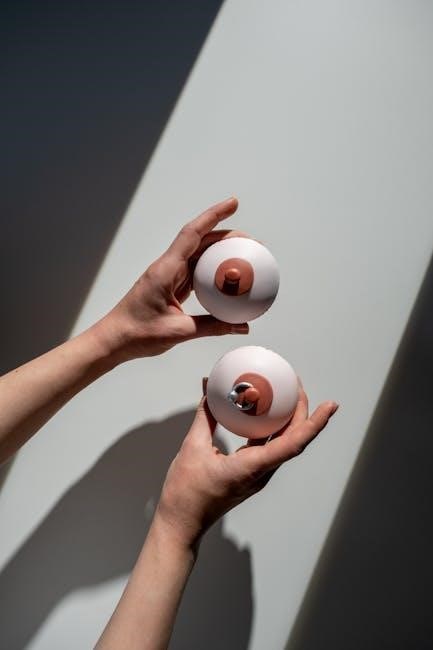Definition and Explanation
Manually flip breast implant refers to a rare complication where the implant flips or rotates after augmentation mammoplasty, occurring in 0-5 of cases․ This condition can cause discomfort, pain, and aesthetic issues for the patient․ The flipping of the implant can be due to various factors, including the type of implant used, surgical technique, and patient’s anatomy․ According to reports, anatomical implants are more prone to flipping due to their shape and design․ Understanding the definition and explanation of manually flip breast implant is crucial to identify the causes and effects of this complication, and to develop effective treatment options․ The condition requires prompt attention from plastic surgeons to prevent further complications and ensure the patient’s overall health and well-being․ By understanding the concept of manually flip breast implant, patients can make informed decisions about their treatment options and recovery process․
Cause and Effect of Implant Flipping
The cause of implant flipping can be attributed to various factors, including the type of implant used, surgical technique, and patient’s anatomy․ The effect of implant flipping can be discomfort, pain, and aesthetic issues for the patient․ According to reports, the flipping of the implant can occur due to the implant’s shape and design, particularly with anatomical implants․ The cause and effect of implant flipping can also be influenced by the patient’s lifestyle and activities, such as exercise or trauma to the chest area․ Understanding the cause and effect of implant flipping is essential to develop effective treatment options and prevent further complications․ The effect of implant flipping can be temporary or permanent, depending on the severity of the condition․ In some cases, the implant may need to be revised or replaced to restore the desired shape and appearance․

Risks and Side Effects of Breast Implants
Risks and side effects include complications, scarring, and implant failure, affecting patient’s health and wellbeing significantly always requiring medical attention quickly and carefully․
Common Complications and Their Solutions
Common complications of breast implants include implant flipping, rupture, and capsular contracture, which can be solved through surgical procedures, such as implant replacement or revision surgery, to restore the desired appearance and feel of the breast․
Patients experiencing complications may require additional medical attention and care to prevent further issues and ensure optimal results, with solutions ranging from non-invasive treatments to more complex surgical interventions, depending on the severity of the complication and individual patient needs, with the goal of achieving the best possible outcome and minimizing risks and side effects, while also addressing any concerns or questions the patient may have, and providing personalized care and support throughout the treatment process, to help patients achieve their desired goals and regain confidence in their appearance․
Types of Breast Implants and Their Characteristics
Types of breast implants include solid silicone and saline implants, each with unique characteristics and advantages, suitable for different patients and procedures quickly and effectively always․
Solid Silicone Implants and Their Advantages
Solid silicone implants are a type of breast implant that does not rupture or leak, making them a popular choice for many patients, they are also less likely to cause complications․
They are made from a solid silicone material that is designed to mimic the feel and look of natural breast tissue, providing a more natural appearance and feel;
Solid silicone implants are also less likely to cause capsular contracture, a common complication of breast implants, and they are also less likely to cause implant flipping․
They are a good option for patients who want a more natural look and feel, and they are also a good option for patients who are at high risk of complications․
Overall, solid silicone implants are a safe and effective option for breast augmentation, and they have many advantages over other types of breast implants, including saline implants․
They are a popular choice among patients and plastic surgeons, and they are widely used in breast augmentation procedures, with good results and high patient satisfaction;

Treatment Options for Flipped Breast Implants
Treatment options include surgical procedures to correct flipped breast implants quickly and effectively with minimal scarring and discomfort for patients overall health and well-being always matters․
Surgical Procedures for Correcting Implant Flipping
Surgical procedures for correcting implant flipping involve various techniques to restore the implant to its original position, including tightening the surrounding tissue or replacing the implant with a new one․
The goal of these procedures is to achieve a natural-looking result while minimizing scarring and discomfort for the patient․
A thorough examination and consultation with a qualified plastic surgeon are necessary to determine the best course of treatment for each individual case․
The surgeon will evaluate the patient’s overall health and medical history to ensure a safe and successful outcome․
In some cases, additional procedures such as capsulotomy or implant exchange may be necessary to achieve the desired result․
A skilled and experienced surgeon can help patients achieve a satisfying outcome and restore their confidence and self-esteem;
By choosing the right surgical procedure, patients can enjoy a more natural and attractive appearance․
Regular follow-up appointments with the surgeon are essential to monitor the healing process and address any concerns or complications that may arise․

Prevention and Maintenance of Breast Implants
Regular check-ups and monitoring are essential for preventing complications and maintaining breast implant health and stability always quickly and effectively every day․
Importance of Regular Check-ups and Monitoring
Regular check-ups and monitoring are crucial for maintaining breast implant health and stability, allowing for early detection of potential complications, including implant flipping, and ensuring prompt intervention to prevent further issues․
By attending regular follow-up appointments, patients can help their clinicians track the condition of their implants and address any concerns or abnormalities, reducing the risk of implant-related problems and promoting overall well-being, with online resources and clinical teams available to provide guidance and support throughout the process, every day, quickly and effectively, always․

and Future Considerations
Future considerations will focus on developing more effective prevention and treatment strategies, as well as enhancing patient education and awareness, to minimize the risks associated with breast implants and ensure the best possible results for individuals undergoing augmentation mammoplasty, with clinicians and researchers working together to address this issue and provide optimal care for patients, every day, quickly and effectively, always, and with the goal of improving overall patient satisfaction and well-being, now and in the future, continuously․
